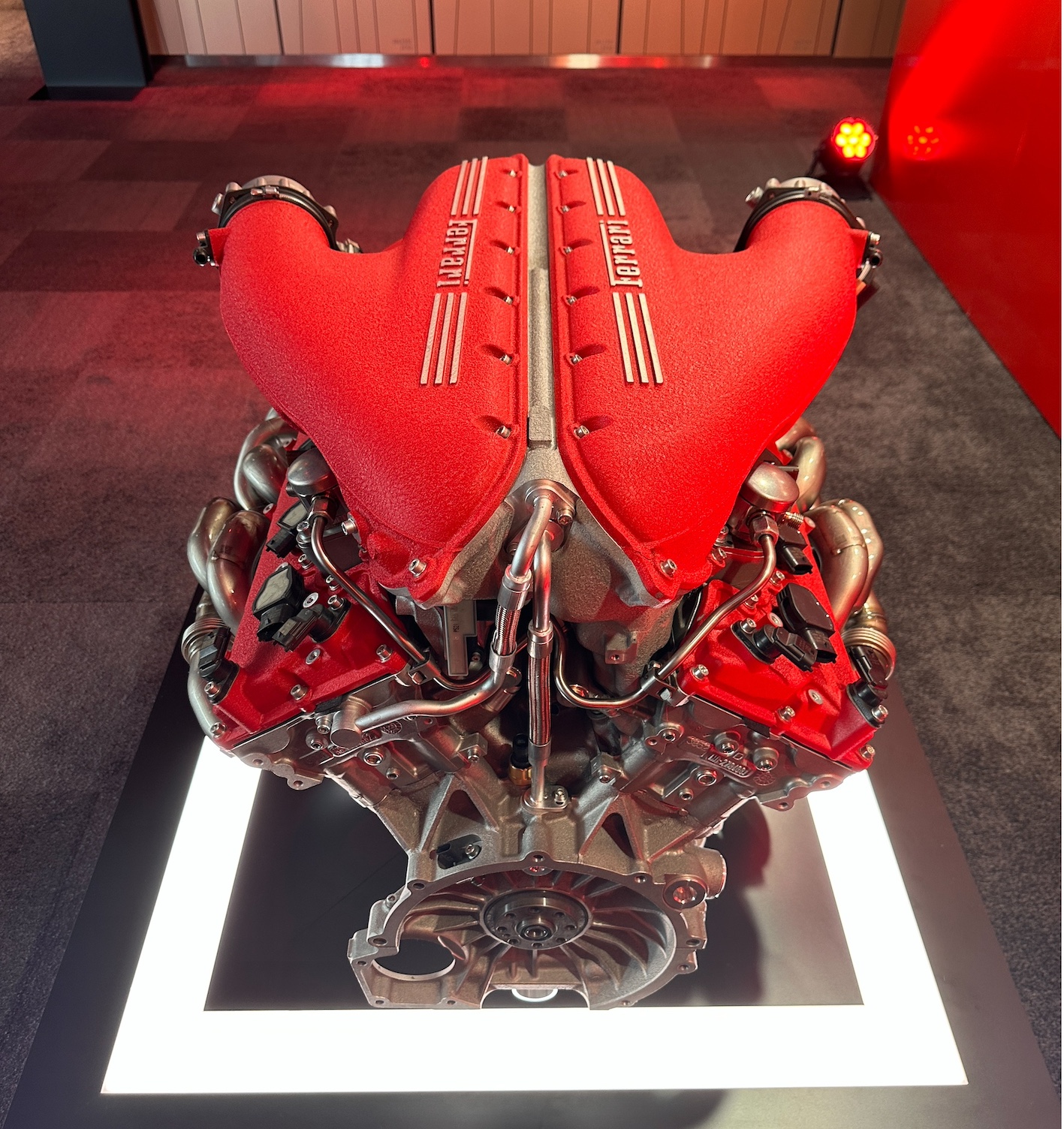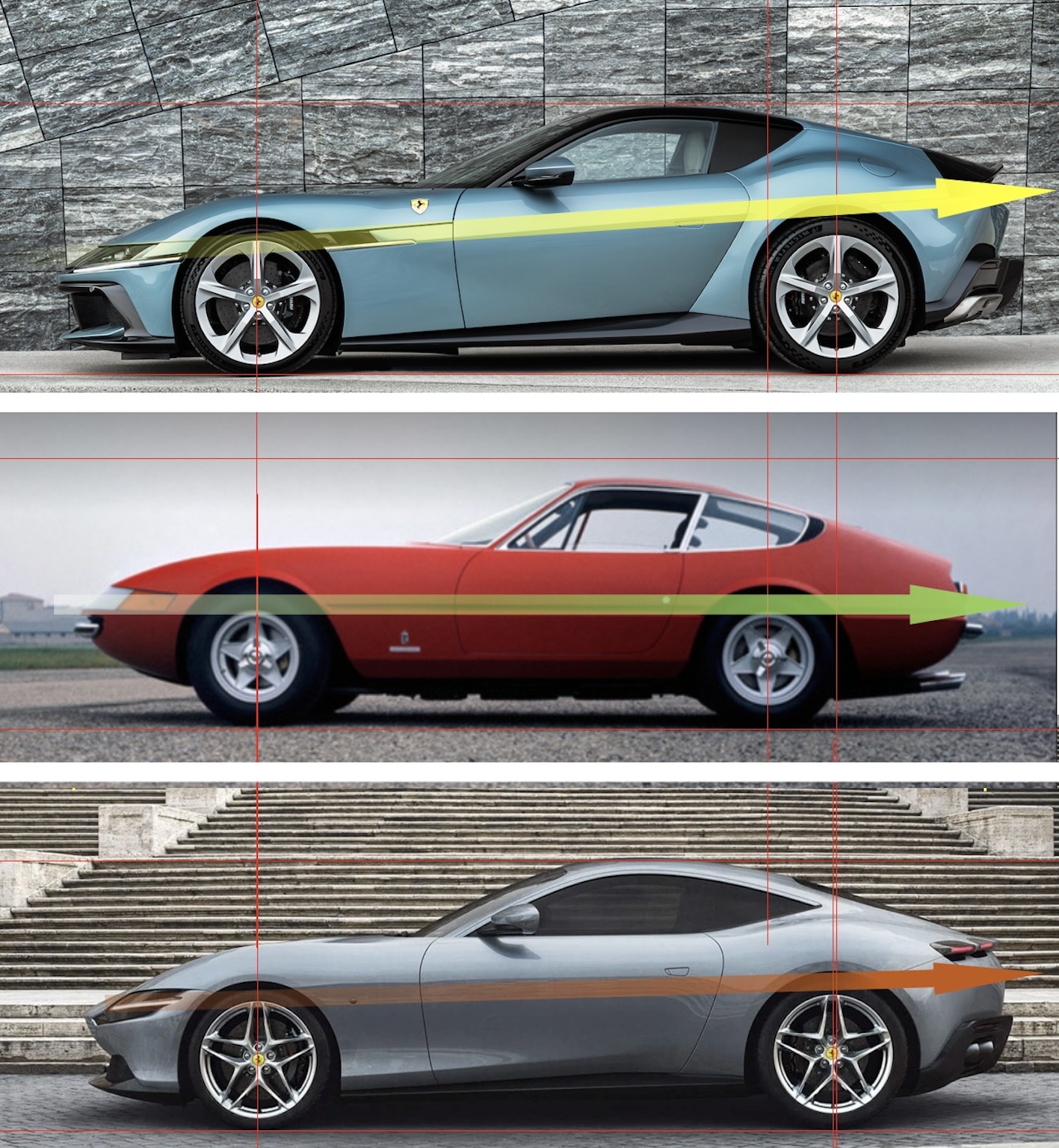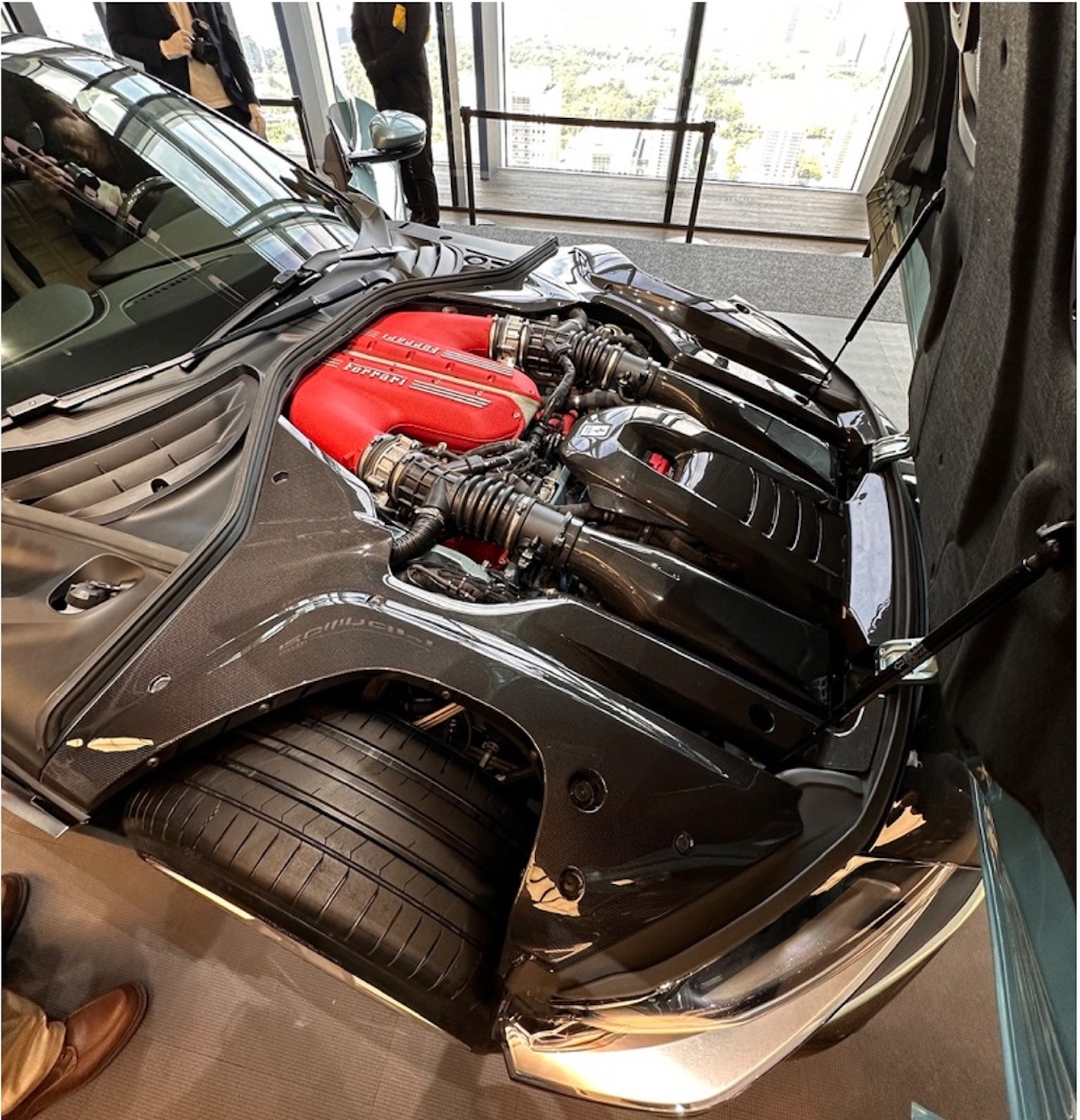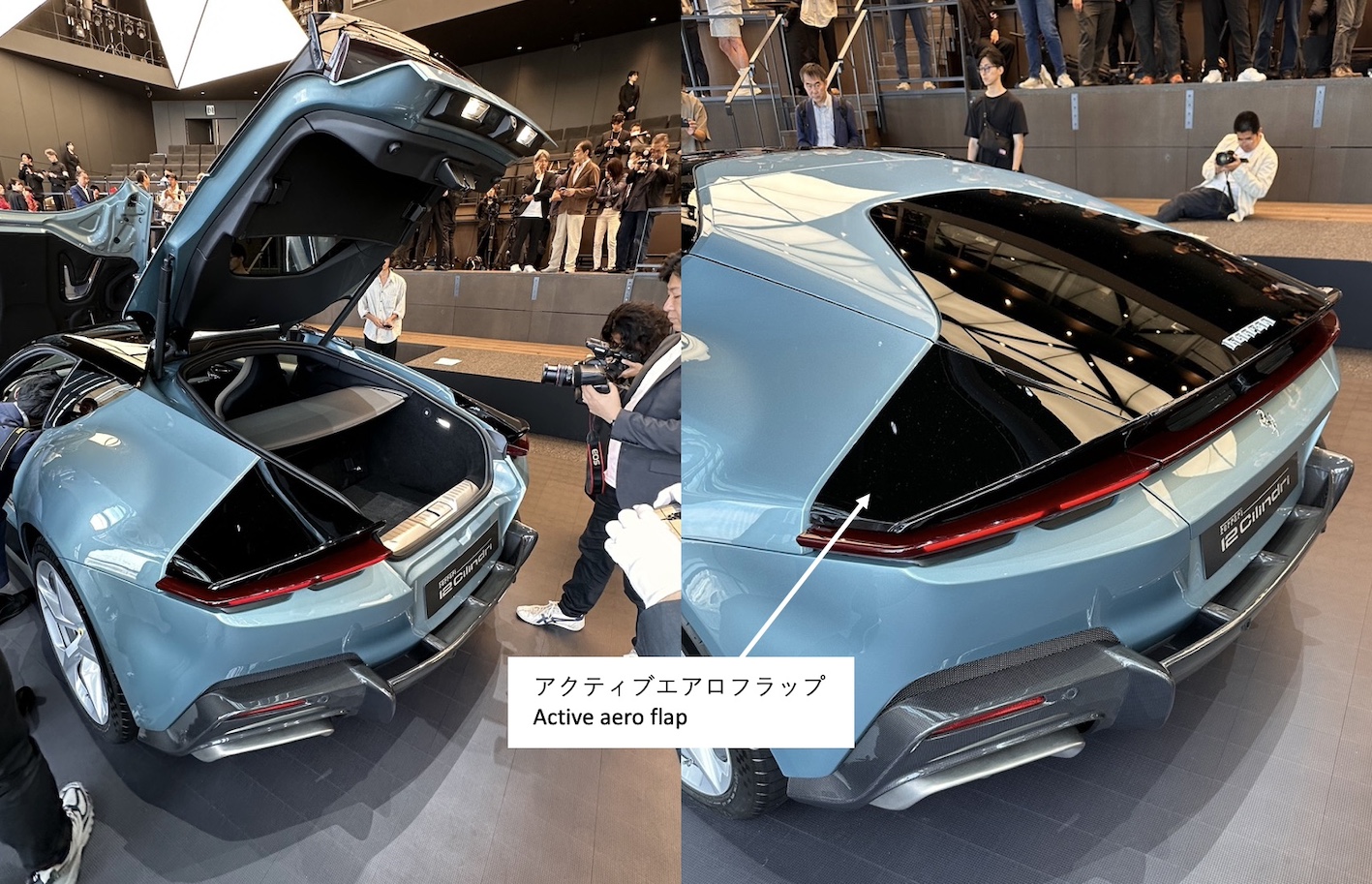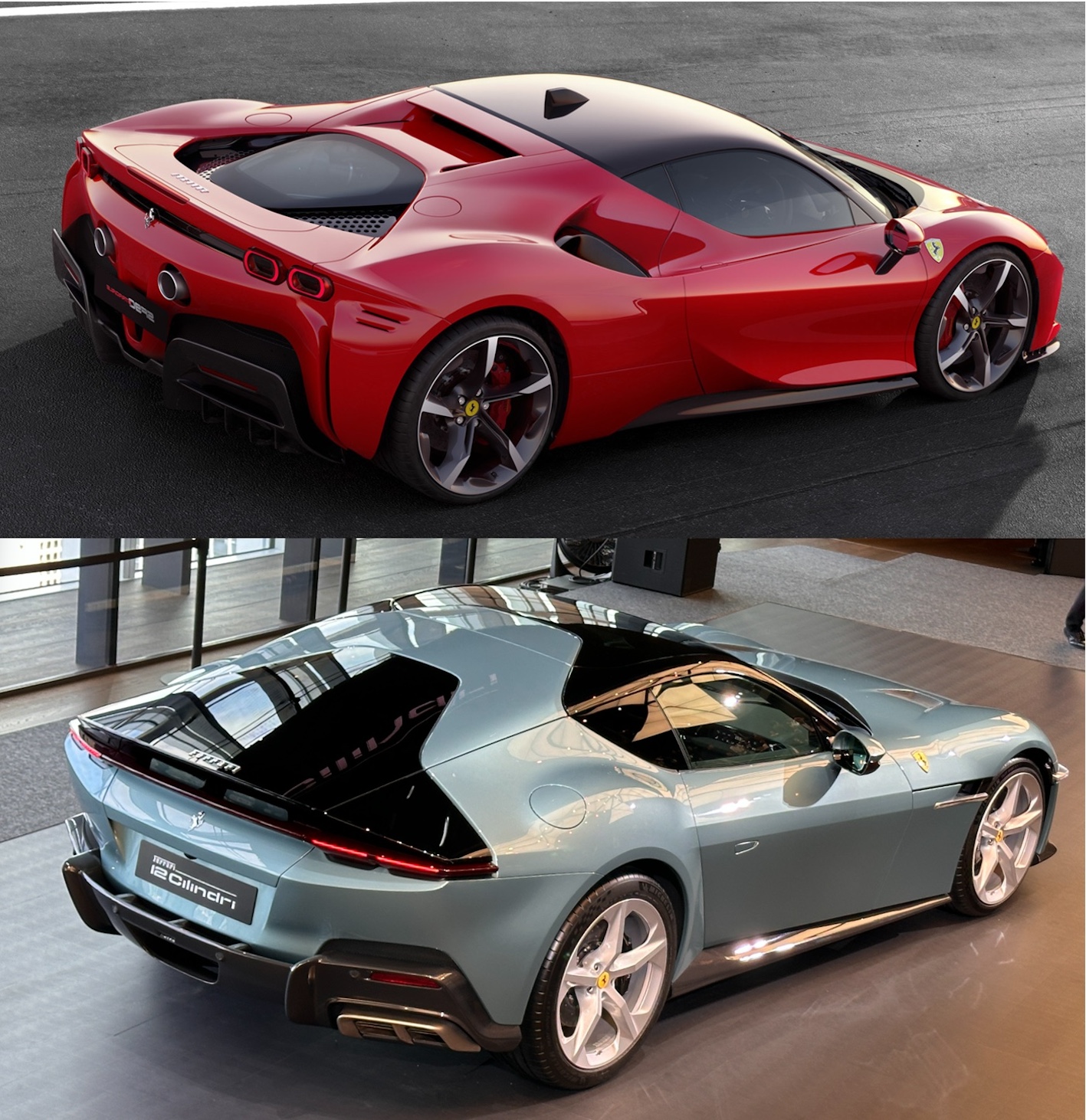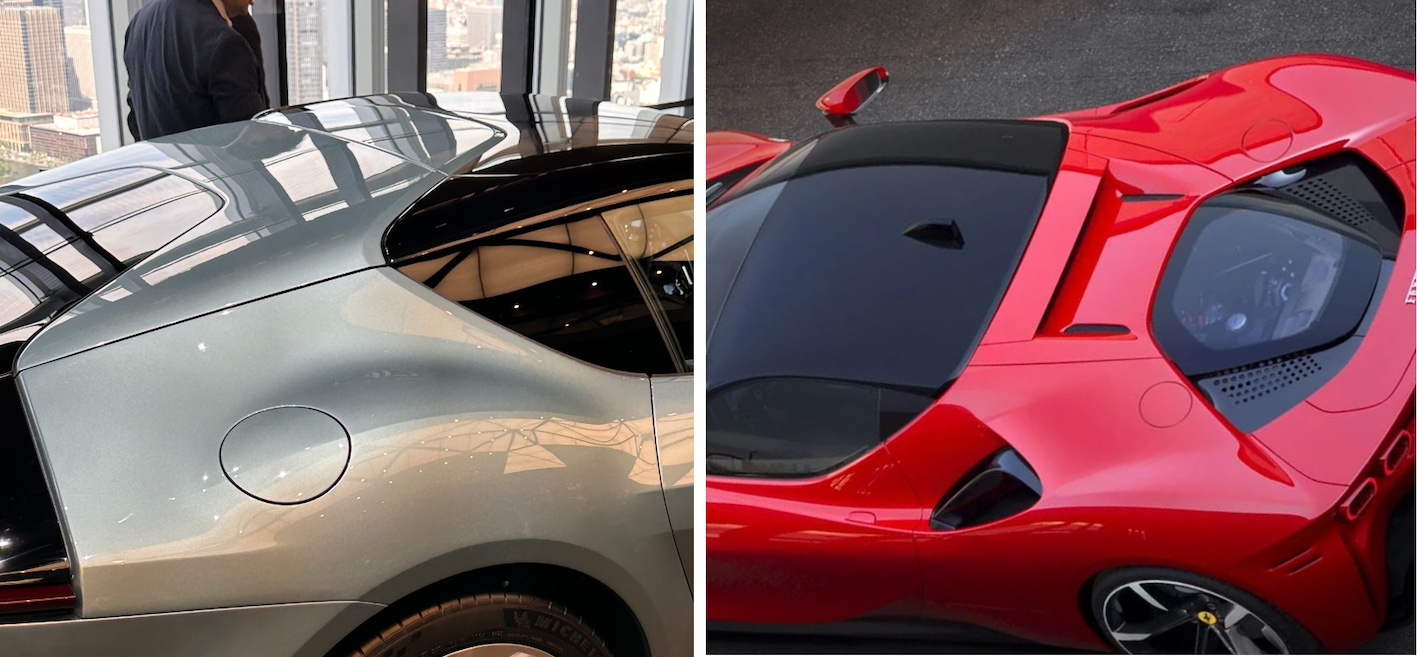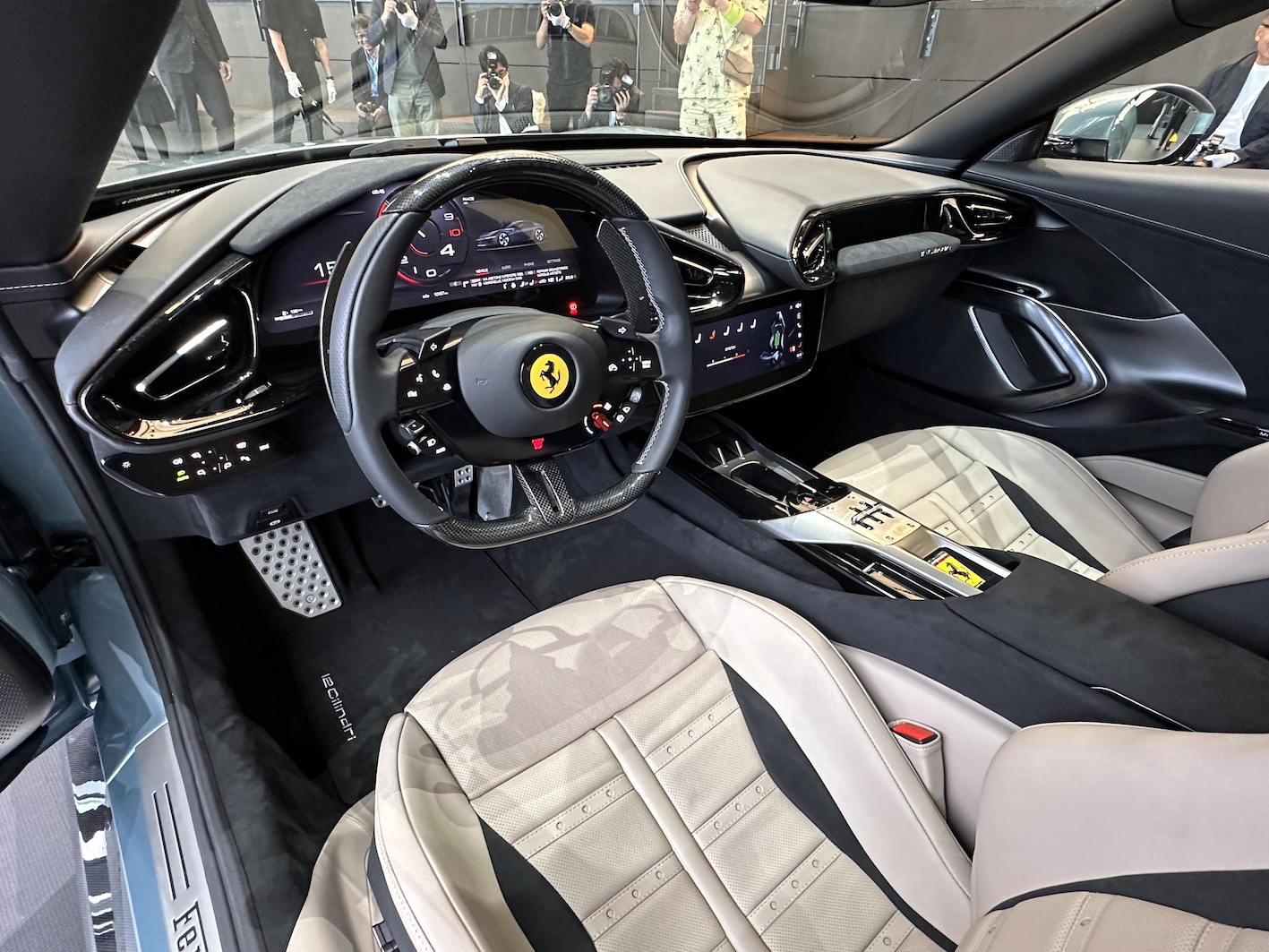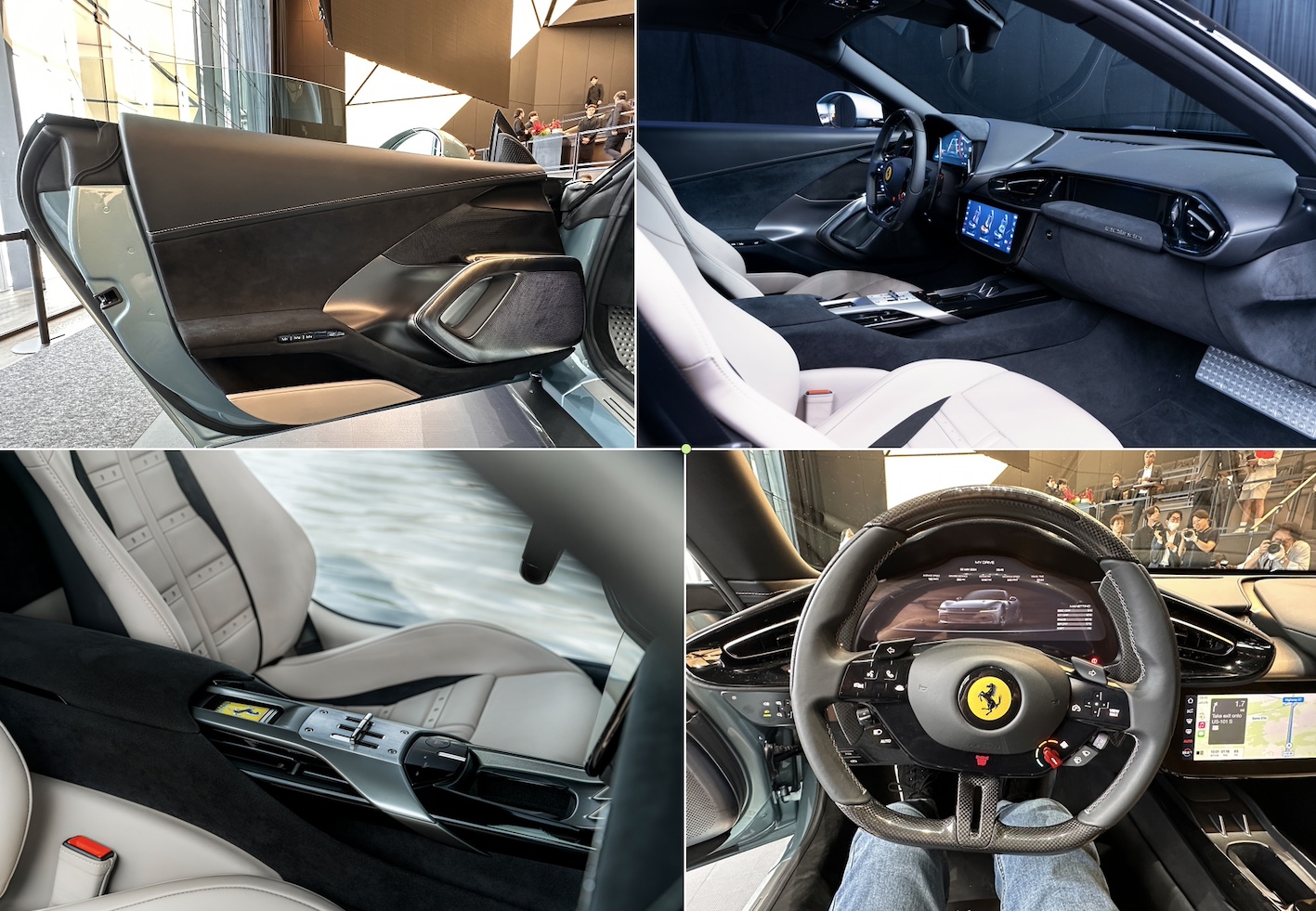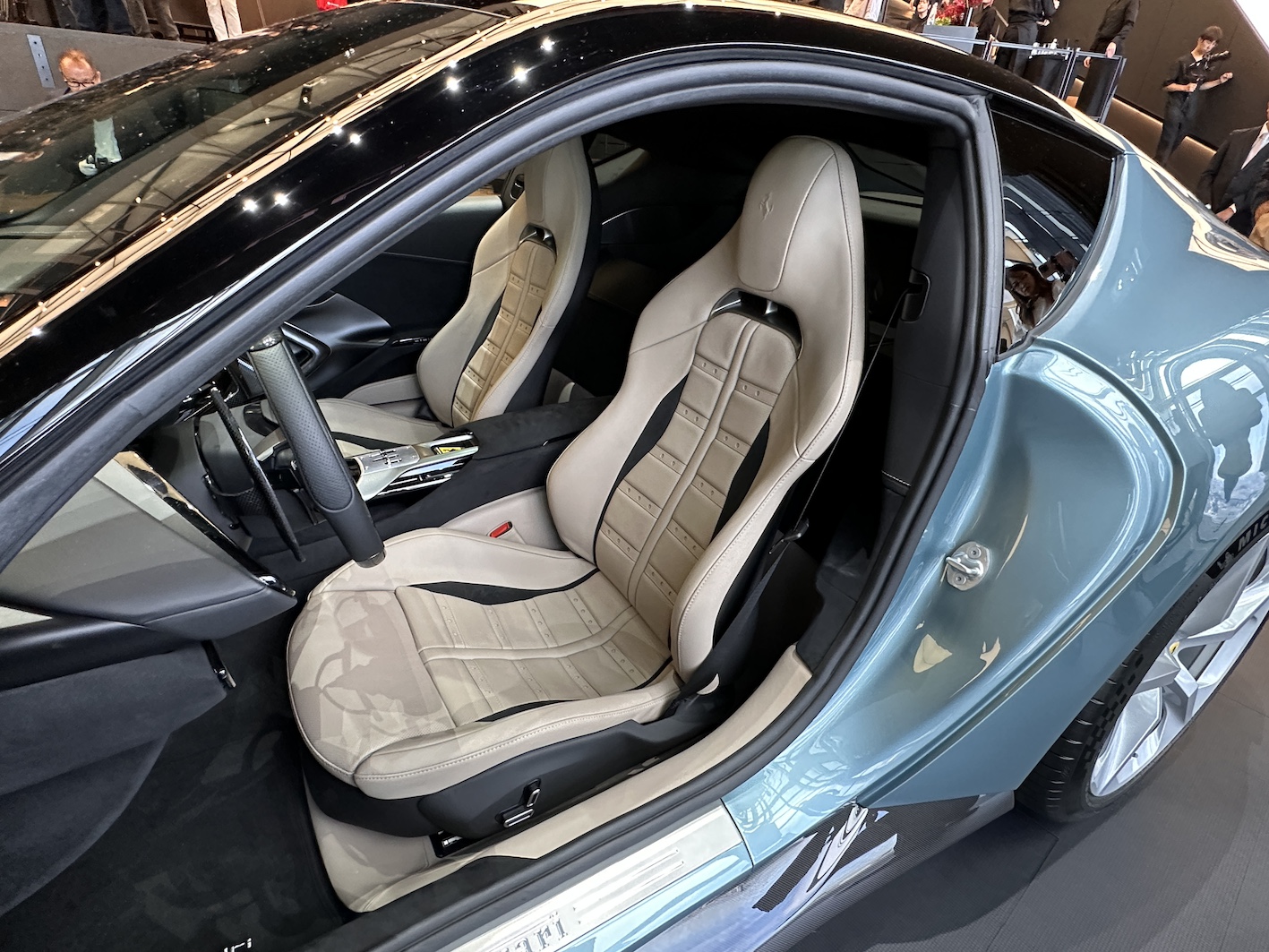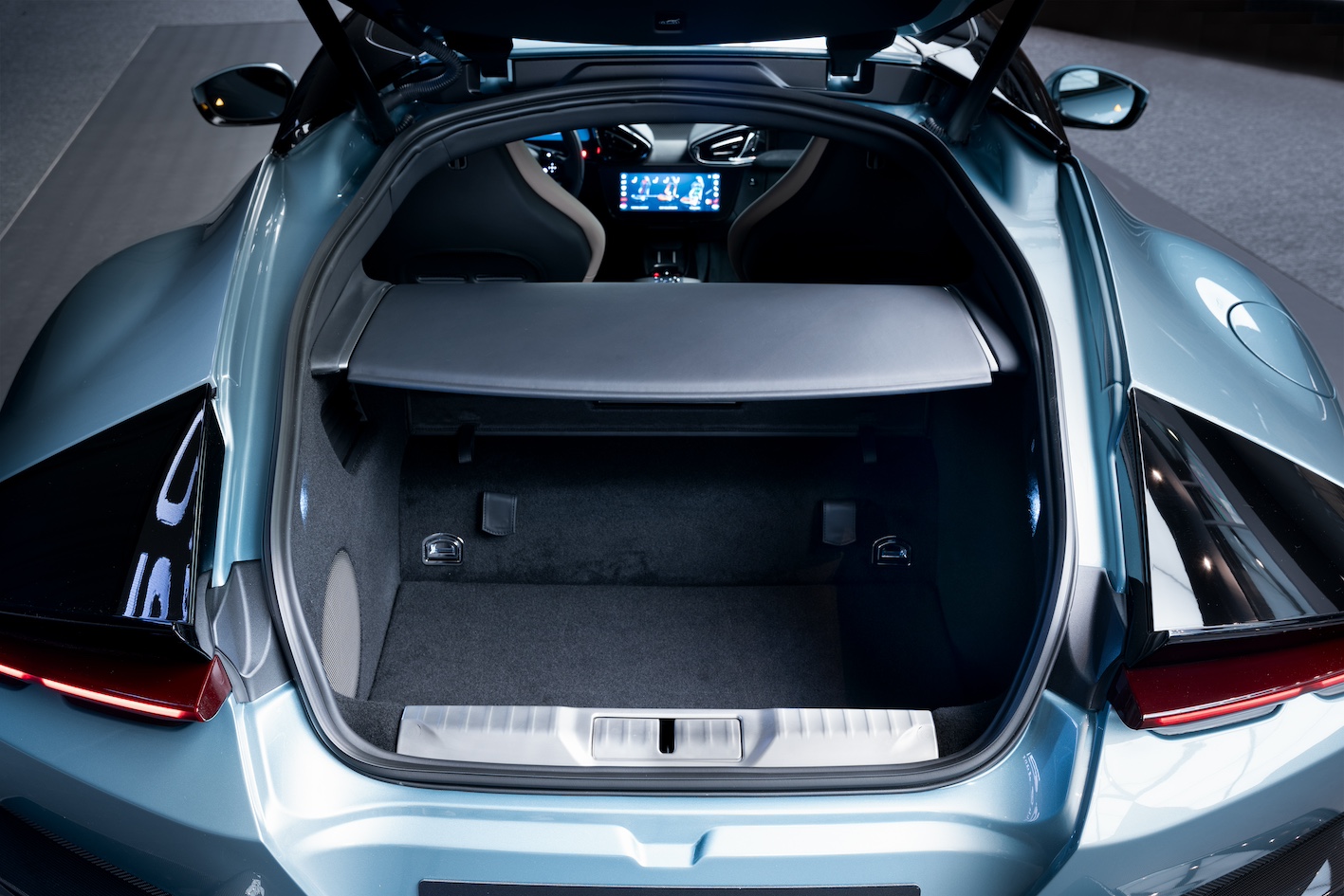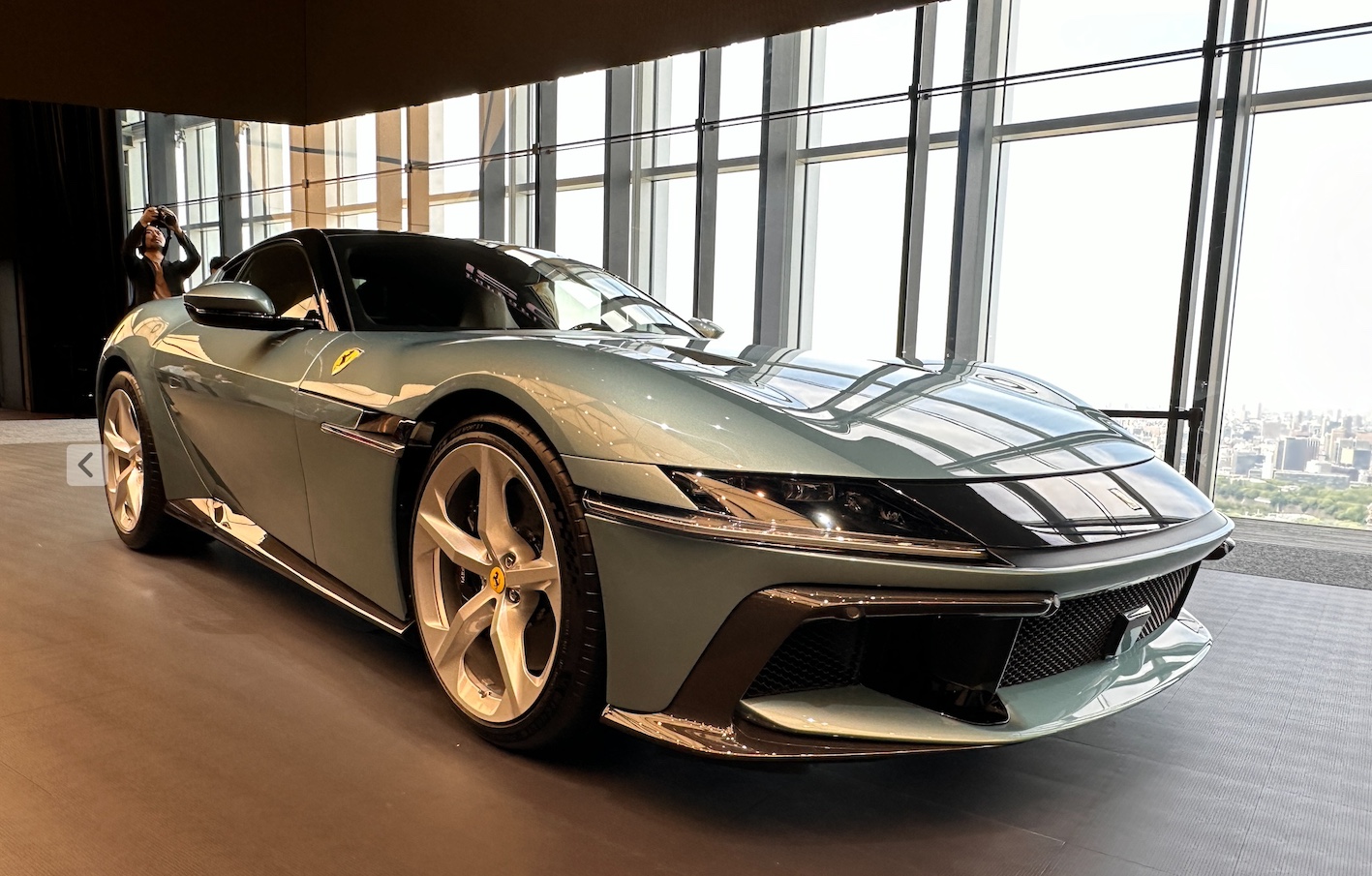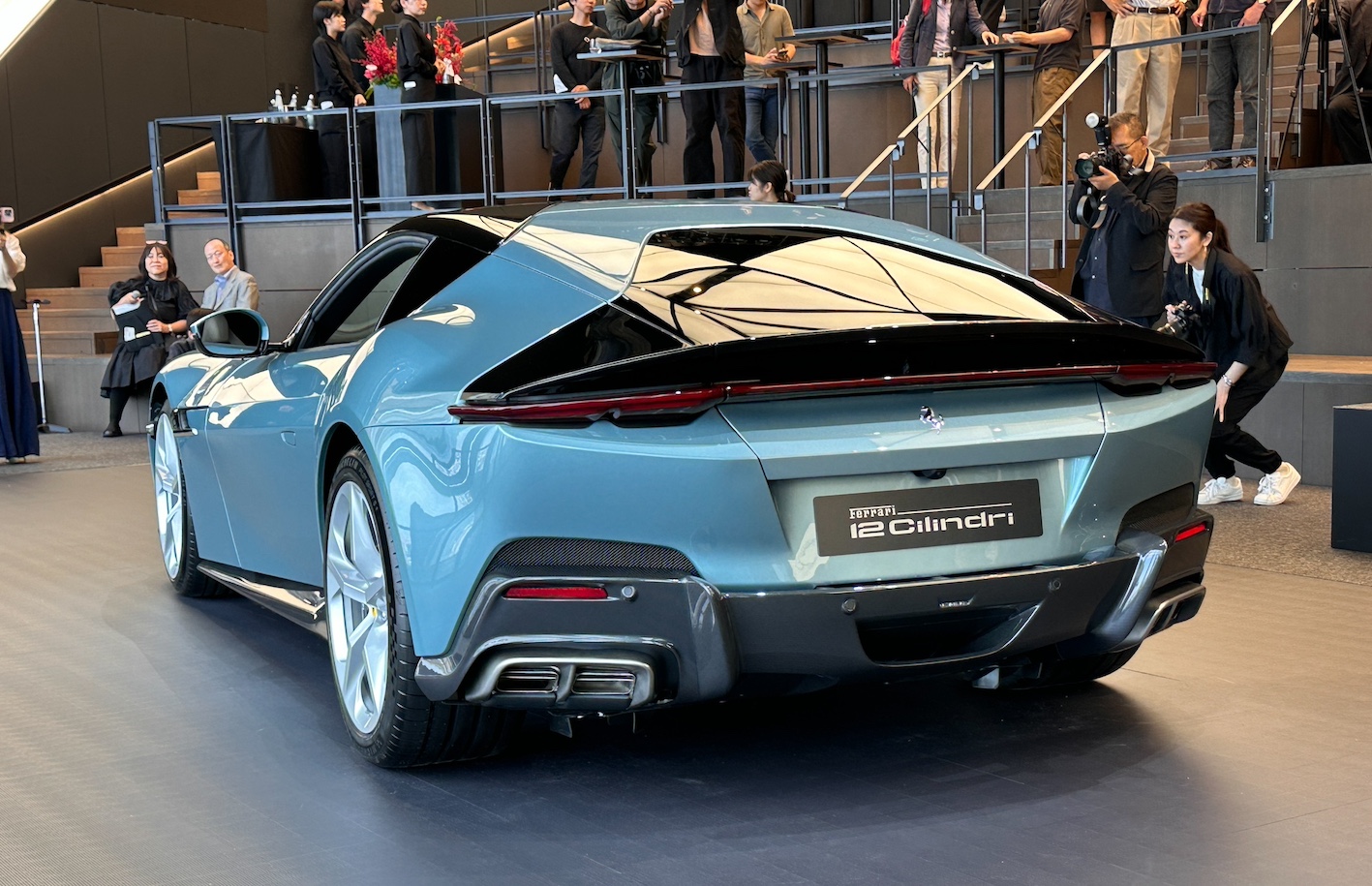日本発表
諸元
全長:4733mm×全幅2176mm×全高1292mm ホイールベース:2700mm
V型12気筒エンジン 総排気量:6496cc
タイヤ&ホイール フロント:275/35R21 リヤ:315/35R21

最高回転数9500rpm トランスミッション 8速DCT 最高速340km/h 0―100km/h 2.9秒
V12・6.5Lエンジンをフロントミッドに搭載した今回のモデルは、ロングノーズ、ショートデッキの典型的なGTシルエットをしている。2019年、V8でSF90StradaleとROMAを登場させ、エアロダイナミクスを可視化させるような性能要件から導き出されたパフォーマンス系のスタイリングと、これまでのフェラーリの歴史にならった品格と優雅さを見せるグランツーリスモ系GTモデルの系譜、のふたつのスタイリングラインに分別させてきたフェラーリチェントロスティーレだが、今回フェラーリのトップレンジとしてのV型12気筒エンジン搭載のフラッグシップをデザインするにあたり、彼らは新たな表現の解釈を提示したように見える。
エクステリア

下:12cilindri
ラップアラウンドしたフロントエンドのブラックベルトの表現と、ボディサイドを走るサイド面を上下に分割するパラレルラインのモチーフから、365GTB/4デイトナの再解釈ではと感じる要素は存在しているが、比較してみれば一目瞭然。両者のプロポーションは全く違う。
彼らは車体を一周するパラレルラインモチーフで古くからのフェラーリファンの記憶に残る伝統からの意匠をうまく利用していると言える。しかしそのモチーフは単純にボディを一周しているわけではなく、それぞれの視点からの効果を計算して使用している。
もしこのモデルが単に365GTF/4のオマージュを狙っているたとするならば、彼らはまったく違ったアーキテクチャーを持つGTに仕立てていただろう。

中:365GTB/4 “Daytona”__1968
下:ROMA( V8/FR )__2019
Ferrari 12V GTの車体軸比較。365GTBはほぼ水平。ROMAはややウェッジ傾向であり、12cilindriのウェッジ軸が最も角度がついている。(ROMAはV8エンジン搭載車)
フェラーリ市販車のトップレンジであるV12・FRのGTは性能を最大に引き出してパフォーマンスするリアルスポーツではなく、その余裕ある性能を持ってグランドツーリングをするためのモデルとして生まれ、水平基調のスタイリングが多い。
サイドビューで見るとフロントから回り込んだラインは勢いよくウェッジしながらリヤホイールアーチのフレアに向かって一気に後方へ突き抜けていて、誰の目にもその動きを感じ取ることが可能だ。そしてラインを平面図で見てみるとフロントフェンダーの全幅からリヤフェンダーに向かってボディ幅を絞り込み、リヤホイールアーチの膨らみを形作るために貢献している。
それは数値として見てみると、
リヤトレッドはフロントよりもボディ片側で20mmほど狭い。これはタイヤ幅の片側サイズ差と同等なので、タイヤの外面(ソトズラ)の位置はフロントタイヤと同一である。だからリヤホイールがボディから出っ張り、踏ん張って見えるようにするためにリヤホイールに向かってボディ幅を狭める必要がある。

さらにリヤホイールでいったん姿を消したボディサイドのパラレルラインはリヤホイールアーチの後ろから復活し、テールランプを収める凹断面の溝へと変化する。

車体を取り巻くこの並行な2本のラインは最もシンプルな形状のヘッドランプ+グリルとテールランプを組み込ませて、フロントとリヤに幅広い印象を持たせるように計画されている。
今回12cilindriでは従来のフェラーリデザインに使われている情緒性豊かな典型的なデザイン処理を可能な限り使用しないことで新しく感じさせるように努力しているように見受けられる。
フロントエンドではヘッドランプやグリルという、あって当たり前の構成要素を消し、フラットでクリーンな形状へと一体化させた。LED化された昨今のランプスタイリングのトレンドの表現ではあるが、さらにランプであることさえも消そうとしたかったように見える。
エンジンフードはフェンダーと一体にし、オープニングラインをボディサイドに廻すことでエンジンフードをクリーンで幅広く見せている。このフードはフロントヒンジで開く、フェンダー一体のフードを開けばフロントミッドに積まれたV12の赤いヘッドが目に飛び込むのである。
フード上の房内冷却のために設けられたふたつのアウトレットやヘッドランプと一体化されサイドへ回り込むDRLなどの小道具も356GTB/4のフード上のアウトレットや両サイドコーナーのバンパーを彷彿とさせるが、それができるのはフェラーリだからこその特権であり、フェラーリのみが持つ”時”を醸し出している。

12cilindriに持ち込まれた365GTB/4の特徴的なディティール。やはりこれは意図的な演出なのだろう。

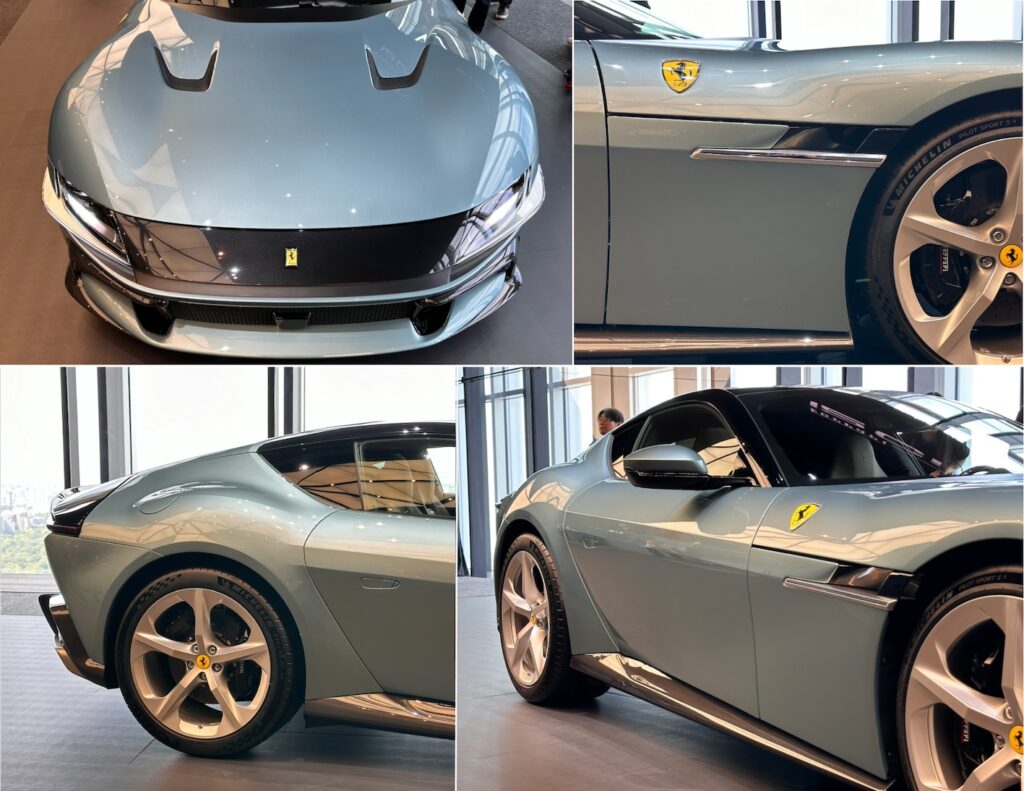
ボンネットから滑らかにシームレスに連続するボディサイド面はダブルのパラレルラインをピークとする整理された面で構成され、幾何学的でボリュームある「力」コブのようなリヤフェンダーと交錯させているのだが、そこに出現するラインはカタチとカタチが相関することでできるラインを素直に見せている。その他の部位でも同様なのだが、今回は「流麗な…」「ボリューム感のある…」というような情緒性豊かで滑らかな繋ぎ形状手法をあまり使用していない。それがこの12cilindriの鮮度になっているのではあるが、ゆえに実はノーズ部で目に入ってくる造形印象と、ボディサイドから後半で感じる造形印象が変わることが気になるところではある。
そしてリヤエンドはこの車の最大の特徴だ
通常はキャビンから後方に伸びるCピラーや、ミッドシップスポーツではフライングバットレスで仕切られたり、削り取られたりしているリヤセクショだが、このモデルではリヤホイールアーチ中心軸位置から立ち上がる幅広いCピラーがジグザグにルーフを跨いで反対側へと繋がる。そのボディ色の帯に囲まれた内側の濃いスモークガラスを利用したリヤウィンド(リヤハッチ)とその左右端に配置されたアクティブエアロフラップ*が形作るブラックなデルタ形状は航空機的*であり、未来的でもあり安定感と幅広さを演出する。このボディの左右を跨ぐボディ色部分は、意味のある構造体のようにも見え、力強くも見える。この部位について、フェラーリのデザイナー達はSF的な発想だったと発言している。
*アクティブエアロフラップ:車速60km/h〜300km/hで最大10度可動する。
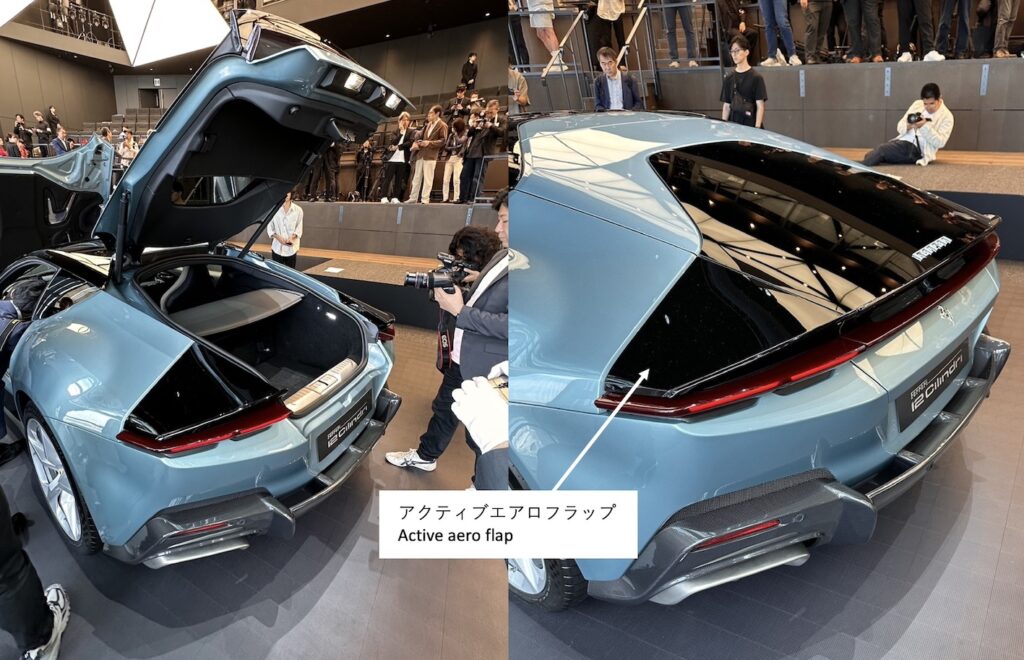
*航空機的:ギリシャ文字のΔ(デルタ)型の翼をデルタ翼(三角翼)と呼ぶ。欧州の戦闘機に多く見られ、イギリス・ドイツ・イタリア・スペインが共同開発した「ユーロファイター」、フランス製の「ラファール」、スウェーデン製の「グリペン」などがある。
そして左右のパラレルモチーフラインから回り込んだ溝に埋め込まれた扁平のテールランプもデルタ形状と一体化して独自の新しい表情を見せている。このリアパートの見え方が12cilindriの最大の見せ場であり、この車のスタイリングの考え方が集約されている。
実はこの部分の造形の考え方は2019年のSF90Stradaleにも存在している。やはり力強く膨らんだリヤホイールアーチの軸中心位置からいかにもトラスを組むように構成された幅広いピラーとリヤスポイラーに囲まれたミッドシップのエンジンベイはデルタ型を形成し、まさに今回の12cilindriのリアセクションの造形へとつながっているように思われる。
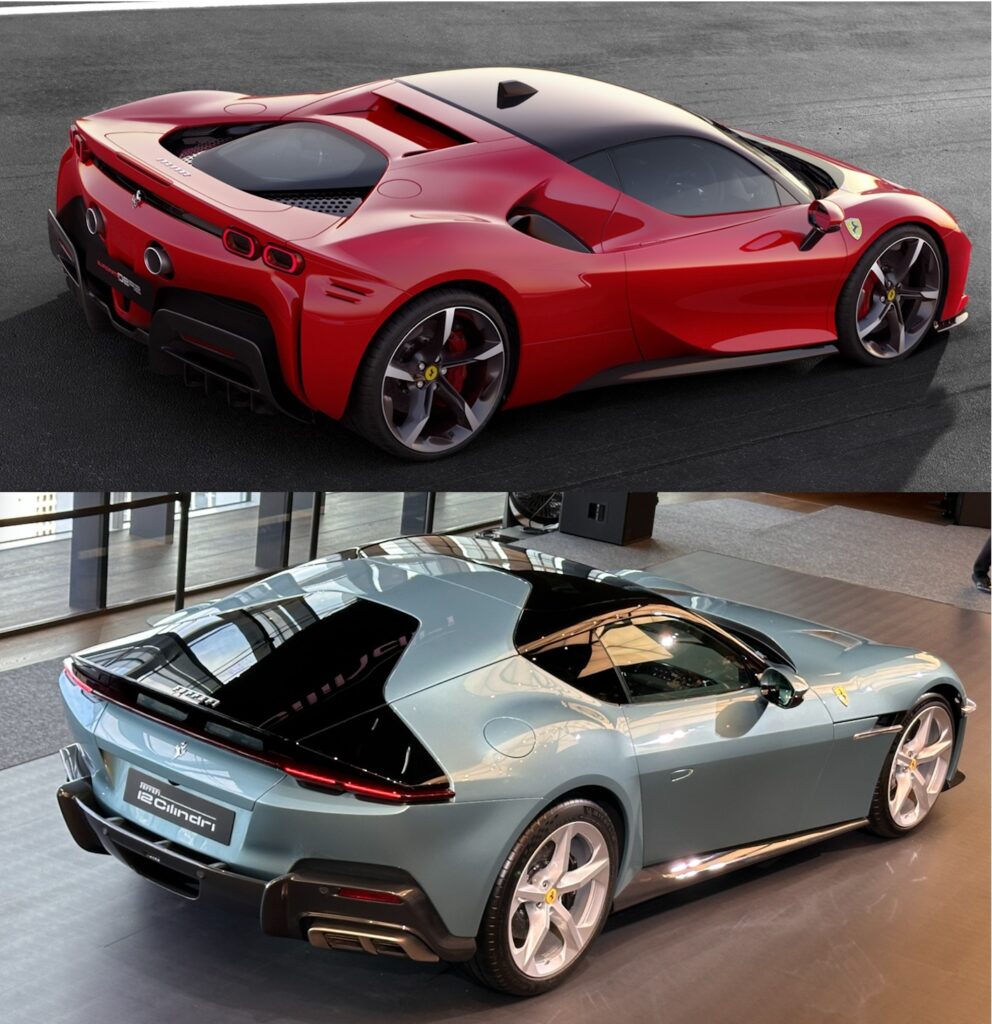
下:12cilindri
SF90Stradaleで造形されたリヤ周りはミッドシップ車のこれまでの典型からカタチ作られたフライングバットレスからの脱却をした結果だ。多くの場合フライングバットレスではルーフとボディエンドを視覚的に滑らかに結ぶように形作られているが SF90Stradaleでは非常に頑丈なロールバーのような構造的な見せ方をした。この時に生まれたデルタ形状の進化型が12cilindriに昇華したわけだが、いかにもグラフィック的なデザイン言語だけには取られないようにディティールを作り込んでいる。また、ボディサイド面のセクションや、力強いリヤホイールアーチとの組み合わせなど、フェラーリのスタイリングセクションはフェラーリのアーキテクチャーを戦略的に継続させてブランド表現をしている。
このルーフからデルタにかけてフラッシュに連続するテーマだが、単に色分けされているのではなくボディ色のピラーと黒色パート部の境界にはC面が加工され、ピラーが表面的なグラフィックデザインとしての表現に陥らずに、骨格としての剛性感を感じるように造形している。
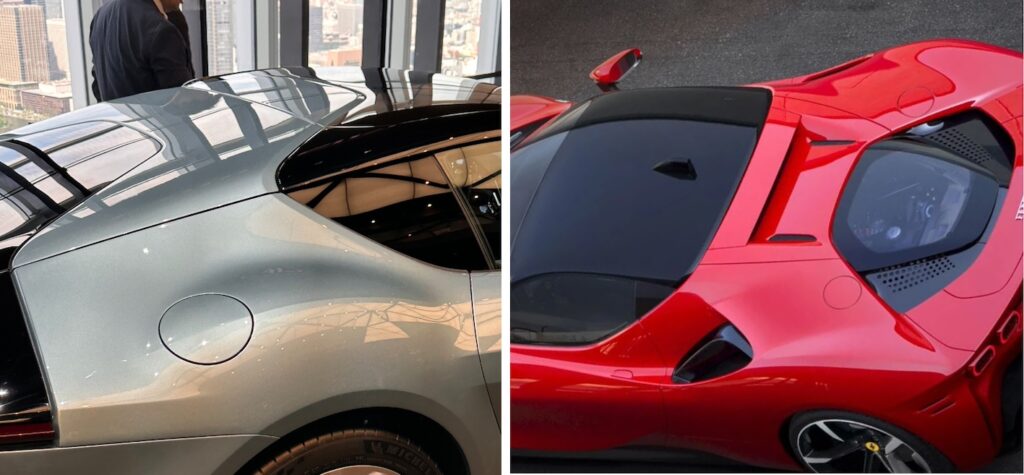
右:SF90Stradale 2019 PHOTO BY FERRARI
ボディ色とブラックパートの境界線には小さな面取りや段差が設けられており、単純な塗り分けに見えてしまうフラッシュサーフェスのひ弱さを回避している。
テールランプが丸から扁平になったのは、同じ年に出たROMAとSF90Stradaleからであり、その考えは今回にまで継続されている。果たしてこの形状は新時代のフェラーリのテールランプであると認識されるようになるだろうか。
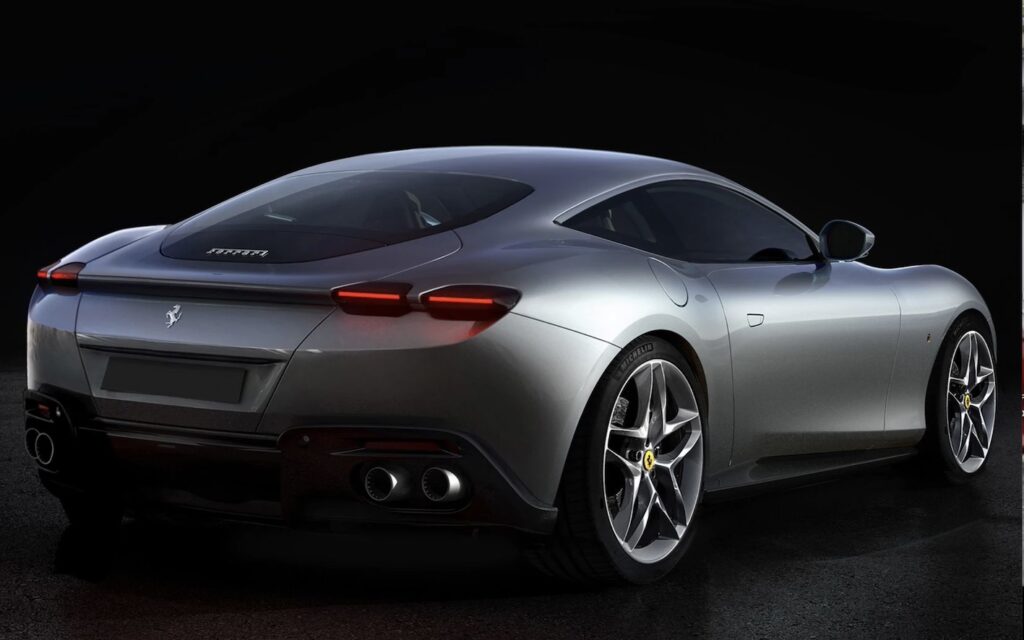

東京発表の車両に装着されていたホイールは5本スポーク21インチ。ボディサイド面の表情と相性の良いカッチリとした面構成の造形。

インテリア
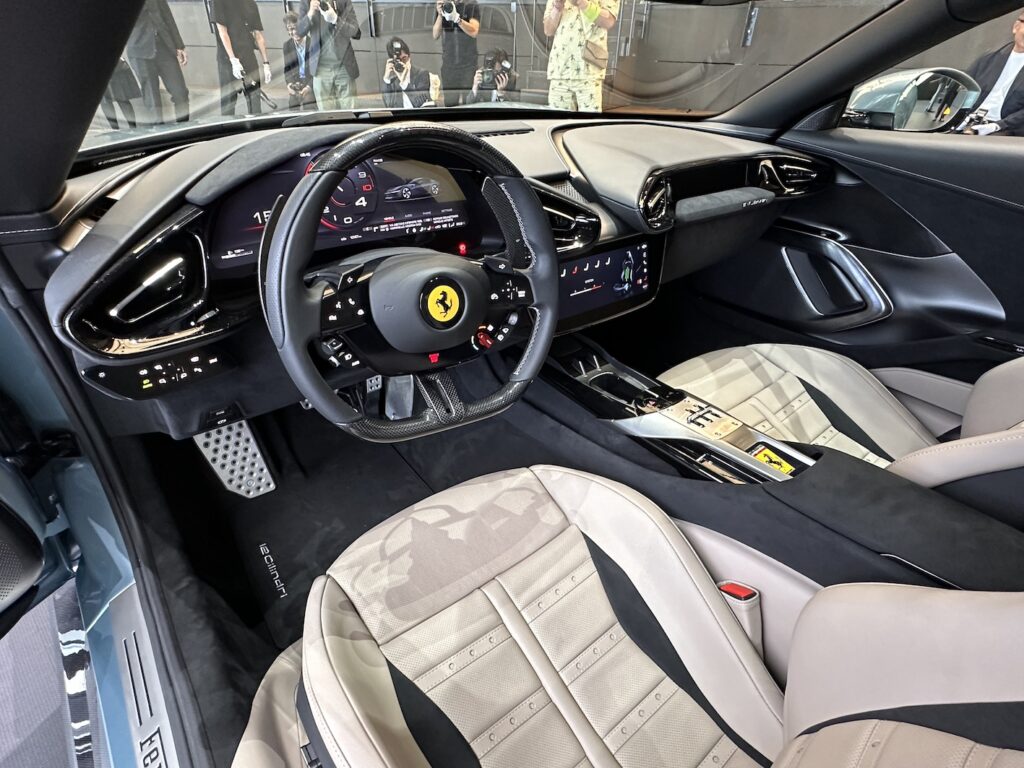
ドライバー席とパッセンジャー席がそれぞれに独立して乗員を包み込むデュアルコックピット。ROMAやPurosangueと同様の造形構成である。運転席、助手席ともに目前のディスプレイを挟んで両サイドに空調の吹き出し口がある構成。ドライバーだけでなくパッセンジャーもドライブを同時に愉しむことができる。運転席のディズプレイは15.6インチ、助手席は8.8インチ。そして車体中央には10.25インチのタッチスクリーンが備え付けられている。

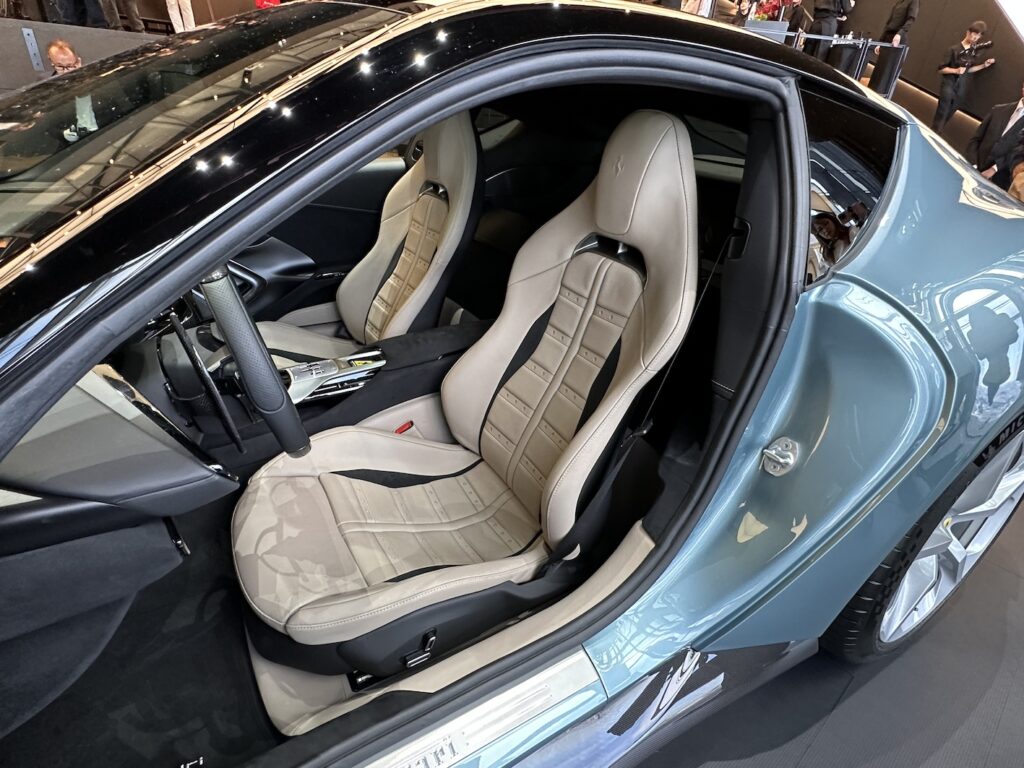
東京でお披露目されたモデルのシートはアルカンターラ仕様。シートはサポート性はあるが、タイト過ぎない。
本革仕様はもちろん、お好みの色でオーダーも可能だそうだ。
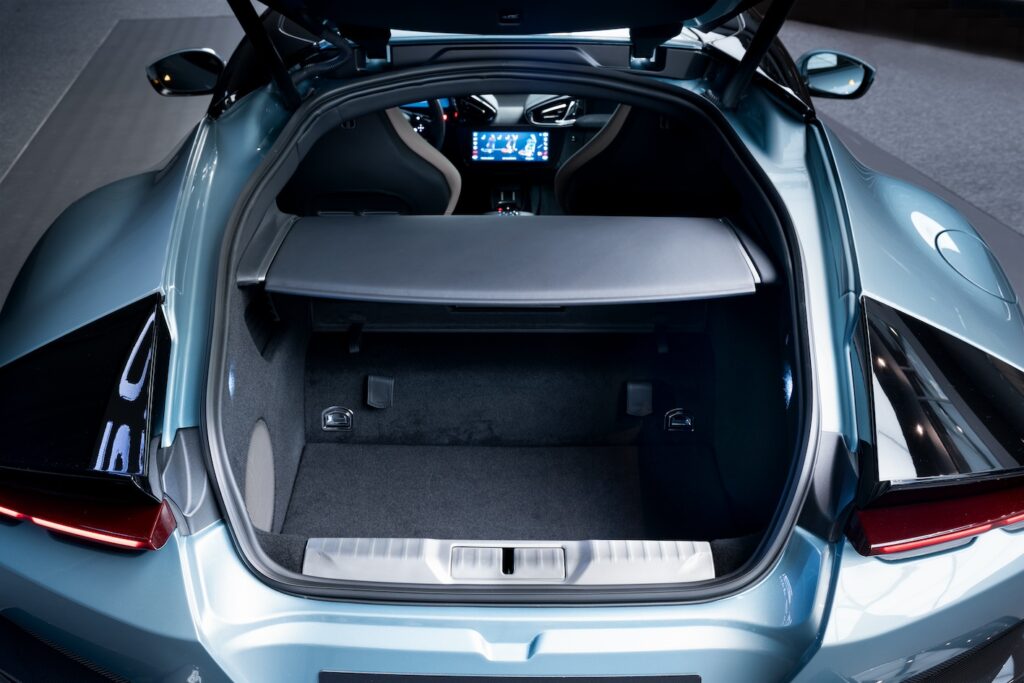
ラゲッジスペースはふたり分の旅行カバンがどうにか収まる程度。
インプレッション
今回の発表会では、すでに5月に北米で発表され画像も出ていたこともあり、静かな感嘆という雰囲気の発表会だったように思う。12気筒をフロントに積むGTはフェラーリの伝統のなかでも常に注目のモデルであり特別な存在だ。さらに2019年にV8ではあるがエレガントで洗練された美しい佇まいのROMAを出しているフェラーリがROMAとは違うどのようなデザインでフラッグシップGTを出してくるのかはとても興味深く待たれていたのだが、12cilindriの造形が溢れんばかりの情熱や、最上級車としての圧倒的な情緒性を発するものではないスタイリングを身に纏って登場したことが、待ち受ける者を冷静にさせたのではないだろうか。
何をもってフェラーリを表現するのかという問いに対しての明確な解答をスタイリングチームもまだ見出していないのか、もしくはマーケティング的な手法を活用し、フェラーリの積み重ねてきた歴史のイメージをうまく匂わせながらピニンファリーナ時代とは違う現代型のフェラーリブランドをマーケットで浸透させようとしているのかもしれない。
例えば、365GTB/4の特徴的なモチーフを借りるだけではなく、フロントフェンダーのボリュームが後方へ流れ、リヤホイールアーチがそれを受け止める造形のリズムは、古くは125Sや166MM。ツーリングのボディを纏った212や、それらを現代解釈したMONZA SP1/2のように、フェラーリ・FR車の歴史の流れの中にあることは確かであり、ロングノーズ・ショートデッキのアーキテクチャーを守りながらも可能な限り新しい造形へのチャレンジをしているからである。

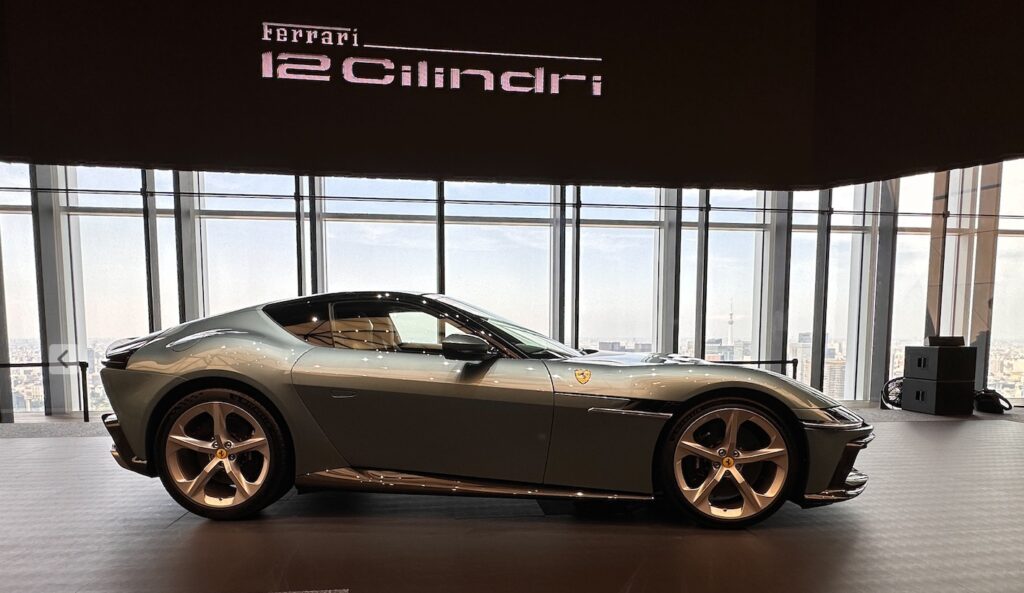

ただ、パッションという側面でみると、この車のデザインは非常に冷静であり、計画され、構築されているのだが、ワクワクするような、このクルマを駆らせずにはいられなくなるような噴き出す感情や、あるいは惚れ惚れと眺めてしまうようなうっとりする感覚は今回の12cilindriからは感じることがなかった。ただし12気筒エンジンをフロントミッドに積むFR車としてのフェラーリのGTのフラグシップとしての品格というものは備えている。
それでも出力パフォーマンスと先進技術を盛り込んだ今回のこのクルマに対して、それを外観でも見せて欲しいと望む方々には物足りないかもしれない。
なぜならば、やはりこの手のクルマには、量産車にはない「私のためにわざわざ作ってくれた」というような一品モノを手に入れるような感覚に近い感情を持ちたいと思うのではないかな、と思ってしまうからなのである。
とはいえ、早く路上で、外光のもとで、その他多くのクルマたちの中で12cilindriを見てみたいものだ。12cilindri がどのように見えてくるのか大変興味深い。
私がいつも言うようにクルマは外光の下で見なければ、デザインの持つ本当のパフォーマンスはわからないのである。残念ながらショールームではデザインの力はわからないし、写真だけでは何も見えないのである。
Design of Ferrari 12[dodici]Cilindri

Debut in Japan
Dimensions
Overall_length 4,733mm x Overall_width 2,176mm x Overall_height 1,292mm Wheelbase: 2,700mm
V-12 engine, total displacement 6,496 liters
Tires & Wheels Front: 275/35R21 Rear: 315/35R21

Maximum rpm 9,500rpm Transmission 8-speed DCT Maximum speed 340km/h 0-100km/h 2.9sec.
The new model, with a V12, 6.5L engine mounted in the front midsection, has a typical GT silhouette with a long nose and short deck.
For 2019, with the introduction of the SF90 Stradale and ROMA with V8, Ferrari Centro Stile has divided its styling into two lines: performance styling derived from performance requirements that make aerodynamics visible, and a lineage of Gran Turismo GT models that display dignity and elegance in line with Ferrari’s history. However, in designing the flagship of Ferrari’s top range with the V12 engine, they seem to have presented a new interpretation of expression.
EXTERIOR DESIGN

Below: 12cilindri
Although there are elements present that feel like a reinterpretation of the 365 GTB/4 Daytona, based on the wraparound front end black belt expression and the parallel line motif that divides the side surfaces running up and down the side of the body, it is obvious in comparison. The proportions of the two cars are completely different.
It can be said that they are making good use of a design from a tradition that has remained in the memories of Ferrari fans for a long time with the parallel line motif circling the car body. However, the motif does not simply circle the body, but is used by calculating the effect from each point of view.

Middle: 365GTB/4 “Daytona”__1968
Bellow: ROMA(V8-FR)__2019_______ALL PHOTOS BY FERRARI
Comparison of Ferrari 12V GT body axles: the 365GTB is almost horizontal; the ROMA tends to be slightly wedged, with the 12cilindri’s wedge axis being the most angled.
The V12 FR GT, the top range of Ferrari production cars, is not a real sport car that performs at its maximum performance, It was born as a model for grand touring with its ample performance, The styling of the GT has been horizontal in many of its predecessors.
In the side view, the line that wraps around from the front wedges vigorously and thrusts backward all the way to the flare of the rear wheel arches, and anyone can feel its movement. And looking at the lines in plan view, the body width narrows from the full width position of the front fenders to the rear fenders, which contributes to forming the bulge of the rear wheel arches.
The rear tread is 20 mm narrower on one side of the body than the front. This is equivalent to a one-sided size difference in tire width, so the outer surface of the tire is in the same position as the front tire. So the rear wheels protrude from the body and the body width needs to be narrower toward the rear wheels to make them look like they are stepping on the body.

Furthermore, the parallel lines on the body sides, which once disappeared at the rear wheels, are restored behind the rear wheel arches and transformed into concave grooves that accommodate the taillights.

These two parallel lines around the body are planned to incorporate the simplest form of headlamps + grille and tail lamps, giving the front and rear a broad impression.
The 12cilindri design seems to have made an effort to create a new feeling by using as little as possible of the emotionally rich typical design treatments used in traditional Ferrari design.
At the front end, the headlamps and grille, which are taken for granted components, were eliminated and integrated into a flat, clean shape. It is an expression of the recent trend in lamp styling with LEDs, but furthermore, it appears that the designer wanted to erase the fact that it is even a lamp.
The engine hood is integrated with the fenders, with the opening line running around the body side, making the engine hood look clean and broad. This hood opens with a front hinge. When the fender-integrated hood is opened, the red head of the V12 in the front midsection jumps into view.
The two outlets on the hood for cooling the engine cell and the DRLs that are integrated with the headlamps and run around the sides are reminiscent of the outlets on the hood of the 356 GTB/4 and the bumpers on the corners of both sides of the car.
The ability to do so is a privilege that only Ferrari has, and it exudes a sense of “time” that only Ferrari has.

Right: 365GTB/4__PHOTO BY FERRARI
Distinctive details of the 365GTB/4 brought to 12cilindri. This is probably a deliberate direction.


The side surfaces of the body, which smoothly and seamlessly continue from the hood, are composed of organized surfaces with double parallel lines at their peaks, intersecting with the geometric and voluminous force-bump-like rear fenders, where the lines that appear are the result of the correlation between shape and form. The same is true for the other parts of the work, but this time they did not use many emotionally rich and smooth connecting shape techniques such as “flowing…” or “voluminous…”. That is what makes this 12cilindri look modern, but I am concerned about the change in the impression of the shape that we see in the nose section and the impression of the shape that we feel in the second half from the body side.
The rear end is the car’s best feature.
The C-pillar usually extends rearward from the cabin, and the rear sectional, which in mid-ship sports is separated or cut away by flying buttresses, but in this model, a broad C-pillar rising from the rear wheel arch center axis position zigzags across the roof to the opposite side. The black delta shape formed by the dark smoked-glass rear window (rear hatch) surrounded by its body-colored band and the active aeroflaps* placed at its left and right edges is both aircraft-like* and futuristic, creating a sense of stability and width. This body-colored area straddling the left and right sides of the body appears to be a meaningful structure and a powerful one.
Ferrari designers have stated that this part was a science fiction idea.
*Active aero flap : Maximum 10 degrees of movement at speeds from 60 km/h to 300 km/h.

It is finished flush in black, so that when the back door is closed, the delta shape looks very clean and integrated.
*Aircraft-like : Wings shaped like the Greek letter Δ are called delta wings (triangular wings). It is often seen on European fighter aircraft, such as the "Eurofighter" jointly developed by the UK, Germany, Italy, and Spain, the French-made "Rafale," and the Swedish-made "Gripen.
The flat tail lamps, embedded in grooves that wrap around the parallel motif lines on both sides, are also integrated with the delta shape to create a unique new look. This rear part is the greatest showcase of the 12cilindri and sums up the car’s styling concept.
In fact, this idea of the shape of the area is present in the 2019 SF90Stradale. The midship engine bay, surrounded by a broad pillar and rear spoiler, which is constructed as a truss from the axial center of the strongly bulging rear wheel arches, forms a delta shape, which seems to be connected to the shape of the rear section of the 12cilindri.

Below : 12cilindri
The rear area sculpted by SF90Stradale is the result of a departure from the flying buttresses that have been the typical shape of mid-ship cars. While in many cases flying buttresses are shaped to visually connect the roof and body ends smoothly, the SF90Stradale has a very sturdy roll bar-like structural presentation. The evolution of the delta shape created at this time has been sublimated into 12cilindri, but the detailing has been created in such a way that it is not taken solely from a very graphic design language. The styling section of the Ferrari is a strategic continuation of Ferrari’s formative architecture and brand expression, such as the body side face section and its combination with the powerful rear wheel arches.
The design theme that runs flush from the roof to the delta is not merely color-coded, but the boundary between the body-colored pillars and the black part has a small chamfer, so that the body-colored pillars are not just a superficial graphic design expression, but also give a sense of rigidity as a framework.

Right: SF90 Stradale _ 2019 _ PHOTO BY FERRARI
The border between the body color and the black part has small chamfers and bumps to avoid the fragility of the flush surfaces that would make it look like a simple paint job.
The tail lamps went from round to flat from the ROMA and SF90 Stradale, which came out in the same year, and the idea has been continued to this time. Will this shape come to be recognized as the tail lamp of the new era of Ferrari?


The wheels mounted on the vehicle presented in Tokyo are 5-spoke 21-inch wheels. The shape of the surface structure is crisp and well matched with the expression of the body side surfaces.

INTERIOR DESIGN

Dual cockpits with separate driver’s and passenger’s seats that envelop the occupants.
The structure is similar to that of ROMA and Purosangue. Both the driver and front passenger seats are configured with air conditioning vents on both sides across the display in front of them. Not only the driver but also the passenger can enjoy driving at the same time. The driver’s display is 15.6 inches and the passenger’s is 8.8 inches. And a 10.25-inch touchscreen is provided in the center of the vehicle.


The seat upholstery material of the model presented in Tokyo is Alcantara. The seats are supportive but not too tight.
They can be ordered in the color of your choice, as well as in genuine leather.

Luggage space is just enough to somehow fit two people’s travel bags.
Impression
The presentation seemed to have an atmosphere of “quiet admiration,” partly because it had already been announced in North America in May and images had already been released.
The GT, with its 12-cylinder engine up front, has always been a remarkable model in the Ferrari tradition and special presence. Furthermore, Ferrari, which in 2019 had released the ROMA, a V8 but with an elegant, refined, and beautiful appearance, was waiting with great interest to see what kind of design, different from the ROMA, they would come up with for their new flagship GT, However, the fact that the 12cilindri appeared with styling that did not emit overflowing passion or overwhelming emotionality as a top-end car may have made those who were waiting for it calm down.
Has the styling team not yet found a clear answer to the question of what represents Ferrari?
Or perhaps the team is trying to use marketing techniques to promote a modern Ferrari brand in the marketplace that is different from the Pininfarina era, while evoking the image of Ferrari’s accumulated history.
For example, not only borrowing the characteristic motif of the 365 GTB/4, but also the rhythm of the shape where the volume of the front fenders flows backward and the rear wheel arches catch it, is certainly in the history of Ferrari FR cars, like the 125S and 166 MM in the past, the 212 with its touring body, and the MONZA SP, a modern interpretation of them.
The reason for this is that they are challenging new shapes as much as possible while keeping the long-nose, short-deck architecture.



In terms of passion, the styling of the 12 Cirindoli is very calm, well planned, well built, and well proportioned, and I can find no fault with it, but I do not feel the overflow of desire to drive this car, the fascination of gazing at it with admiration.
However, as an RWD car with a 12-cylinder engine mounted in the front midsection, it has the dignity of the flagship of Ferrari’s GT lineup.
Even so, those who wish to see the output performance and advanced technology of this new car show it off on the outside may find it lacking.
Because, after all, one would think that with this type of car, one would want to have a feeling similar to that of acquiring a one-of-a-kind production, a feeling that “they went out of their way to make it for me,” which is not present in mass-produced cars.
However, I can’t wait to see the 12cilindri on the street, under the sky, in natural light, and among many other cars. As I always say, a car must be seen in the natural light to appreciate the true performance of its styling. Unfortunately, you can’t see that in a showroom, and you can’t see anything in a photo.

![by Car Styling [カースタイリング]](https://motor-fan.jp/wp-content/uploads/2025/04/carstyling-jp_logo.png)

